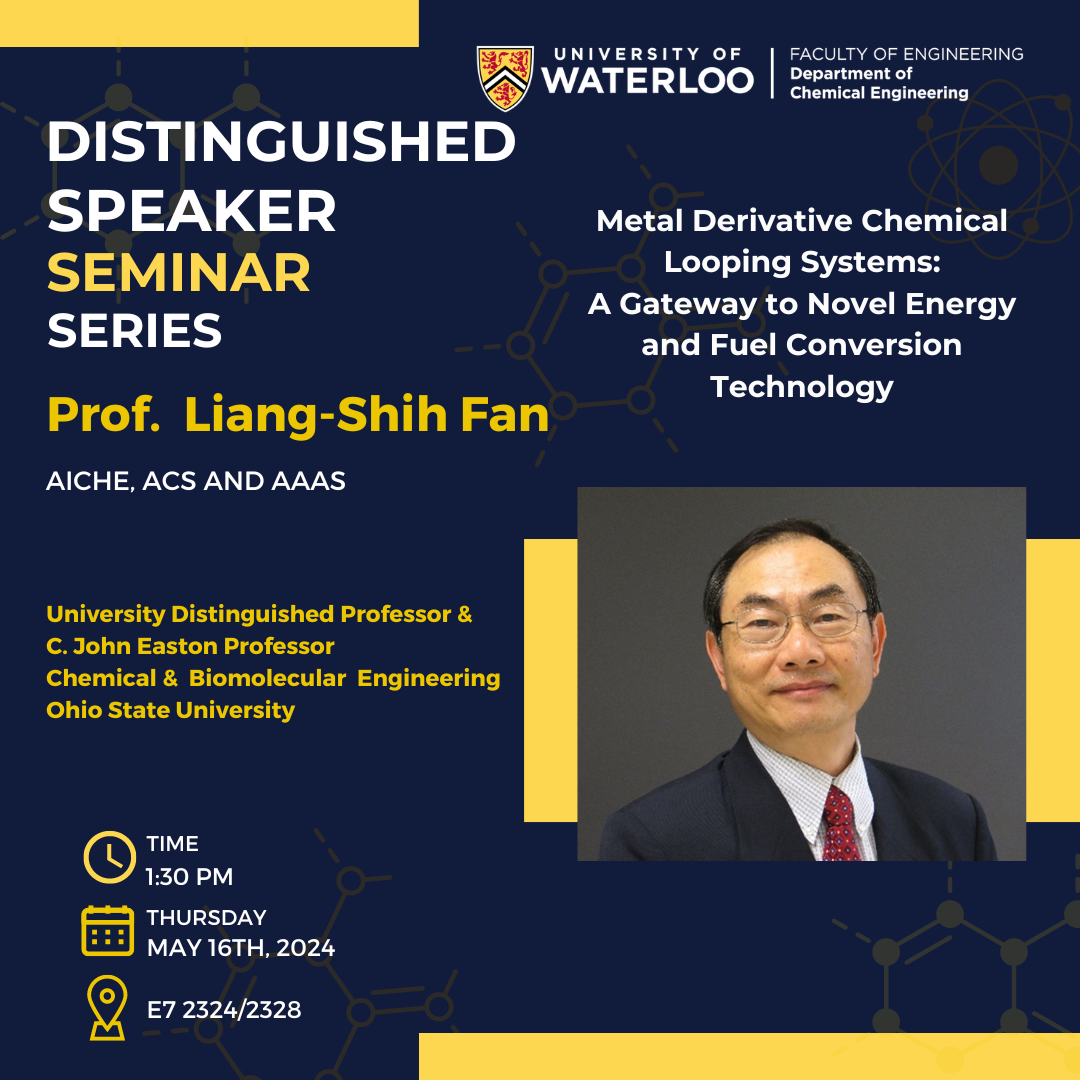
Biography
Biography:
L.-S. Fan is Distinguished University Professor and C. John Easton Professor in Engineering in the Department of Chemical and Biomolecular Engineering at The Ohio State University. His research fields are in particle science and technology, and multiphase reaction engineering. He is an inventor of nine clean energy conversion processes including OSCAR, CARBONOX, pH Swing, Calcium Looping, Hydrogen Looping, Syngas Looping, Coal-Direct Chemical Looping, Dry Reforming, and SULGEN Processes for CO2, SO2, H2S, and NOx emission control and electricity, syngas, hydrogen, chemicals or liquid fuels production. He has also invented the commercially used electrical capacitance volume tomography for three-dimensional multiphase flow imaging. Professor Fan is the Editor-in-Chief of Powder Technology and has authored or co-authored 490 journal papers, 80 U. S. patents, and six books including the most recent textbook (2021) “Dynamics of Multiphase Flows” by Cambridge University Press. He was named as one of the “One Hundred Engineers in the Modern Era” by the AIChE in its centennial celebration in 2008. Professor Fan is a Member of the U. S. National Academy of Engineering, the National Academy of Inventors, Academician of the Academia Sinica, and a Foreign Member of the Chinese Academy of Engineering, the Australia Academy of Technology and Engineering, the Indian National Academy of Engineering, the Canadian Academy of Engineering, and the Mexican Academy of Sciences. He has received over 90 professional honors and awards in recognition of his teaching, research, and services worldwide such as U.S. Council for Chemical Research’s Malcolm E. Pruitt Award, ACS’s E. V. Murphree Award in Industrial and Engineering Chemistry, AIChE’s Alpha Chi Sigma Award for Chemical Engineering Research, Warren K. Lewis Award for Chemical Engineering Education, 67th Institute Lectureship, and Particle Technology Forum Life-Time Achievement Award, Engineering Foundation’s International Fluidization Achievement Award, Chinese Academy of Sciences’ Einstein Professorship, and Ohio State University’s Innovator of the Year Award, Joseph Sullivant Medal, and President and Provost’s Award for Distinguished University Service. He is a Fellow of AIChE, ACS and AAAS and has served as the research advisor to 14 undergraduate students for honor theses, and 49 MS and 94 PhD graduate students and 72 post-doctoral research associates.
Abstract
The science and engineering of metal derivative-based chemical looping technologies are characterized by the interplay among a broad spectrum of subjects concerning metal derivative physics, chemistry and reaction engineering, and particle science and technology. Specifically, these technologies encompass three main components - Materials: metal derivative material synthesis, reactivity, reaction-regeneration mechanism, recyclability, and physical strength; Reactors: flow pattern and stability, gas-solid contact mechanics, scaling rule; and Systems: process integration, intensification, and optimization. Such interplay is of multiscale and is so complex that it has been over 100 years that the chemical looping technology has not been able to be successfully commercially deployed.
The major advances made recently, however, have changed the outlook of this technology of which the commercialization is now realistically realizable.
Using metal oxides as an example, these advances include the successful development of chemically, physically robust metal oxide oxygen carriers that are cost-effective and sustainable to long-term redox reactor environment.
They also include the successful employment of CO2 and H2O as partial substitute of carbonaceous feedstock for combustion, gasification and reforming applications thereby yielding CO2 negative chemical looping processes that are applicable also to dry or mixed reforming without concern of carbon deposition as commonly experienced in catalytic systems. These advances coupled with a novel reactor design and operation can give rise to a significant reduction in the capex over that with conventional process technology approaches in the production of electricity, hydrogen, syngas, liquid fuels, and chemicals. The general concept of chemical looping can also have varied technology applications, featuring it as the platform technology.
For example, the SULGEN Process recently invented at the Ohio State University (OSU) can be in one step capturing H2S with another step separating it to hydrogen and sulfur. It can potentially be applied to petroleum fuel refining, natural gas sweetening, and other fossil fuel gasification and reforming processes, in place of the Claus process. This presentation will describe these advances that are established over the OSU chemical looping platform system. The presentation will also illustrate the rationales of its commercialization readiness in light of the recent OSU licensing of this chemical looping technology to Babcock and Wilcox Company for commercial production of hydrogen utilizing a variety of carbonaceous feedstocks with a projected commercial plant to be constructed and operated in 2025. A relevance to the possible engagement of the membrane technology in association with the applications of the chemical looping process operation will be discussed.